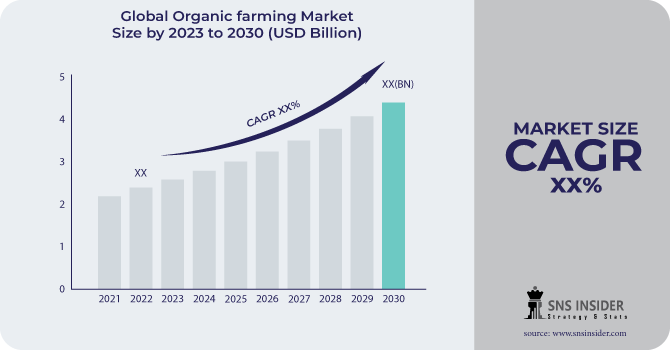Organic Farming Market Report Scope & Overview:
The Organic Farming Market is considered to be on growth stage during the forecast period. It is been noticed that organic farming market has a great potential of providing good healthy and high-quality food. Foods from organic foods are rich in enzymes, vitamins and minerals and many other which are not easily available in the conventional farm foods. Organic farm has its own environmental benefits which include soil fertility and reduces the greenhouse gas. Government has been taking a lot of initiative to promote the organic farming as the awareness of using organic farming and the environment benefits has been acknowledged. Various schemes have been launched by the governments to promote the organic farming is itself the biggest opportunity for the companies as well as the investors.

Impact of COVID-19
Covid-19 has clearly made people realize that being fit and healthy is the only option to live a good life. So, people are more concerned about having a good and healthy meal where organic food comes into picture the benefits which humans get due to the vitamins and minerals present in it is the driving factor for organic farming global market.
During covid the severe problem of supply chain management was the only constrain due to which this market faced a severe issue, The production and also the other resources got disrupted due to the rules and regulations of covid-19.
Market Dynamics:
Driver
-
Increase in demand for organic farming food
-
Rise in awareness of benefits due to consumption of organic farming food
Restrain
-
Lack of awareness of organic food farming in emerging countries
-
Production cost is higher compared to conventional farming
Opportunity
-
Government Initiative and schemes in favor of organic farming market
Challenges
-
Stringent Regulatory System of some regions
Impact of Russia Ukraine War
As they are the major countries of agriculture sector, the war between them has disrupted the whole global food securities as the demand of organic food was high post covid which resulted in recovery of revenue, The major issues of covid 19 was the supply chain which disrupted this market but when we look closely toward the Russia Ukraine war the investors and companies are worried about the quality of raw material which will be imported from these countries which might result towards the lack of raw material hence the prices will surely get affected.
Impact of ongoing recession:
Recession brings into economic disturbance among the nation also the socioeconomic development gets hampered because of the recession, healthy food will always be the major factor for the people even if there is a recession or not because covid has taught everyone health is the only important factor apart from anything else, so healthy food gives several benefits which include vitamins minerals, fibre which is very necessary for the body also the immune system gets build very strong so considering all the factors organic farming growth will be not an issue during the recession only keeping the economic condition in mind the prices has to be set but the demand curve will not have that much of impact .
Regional Analysis:
North America is considered to have the high market share in organic global market due to the increasing demand and the increasing awareness among the people regarding the organic food,
Whereas APAC is also the fastest growing region the major reasons behind that are the initiative taken by the government to introduce the new schemes also the support to the local farmers and also providing subsidies on organic fertilizers.
Europe recorded around 20-25 % market share for organic farming market.
Market Segmentation:
By Application:
-
Agriculture Companies
-
Organic Farms
By Product Type:
-
Pure Organic Farming
-
Integrated organic farming
By Distribution Channel:
-
Direct
-
Indirect
Regional Analysis:
-
North America
-
USA
-
Canada
-
Mexico
-
-
Europe
-
Germany
-
UK
-
France
-
Italy
-
Spain
-
The Netherlands
-
Rest of Europe
-
-
Asia-Pacific
-
Japan
-
south Korea
-
China
-
India
-
Australia
-
Rest of Asia-Pacific
-
-
The Middle East & Africa
-
Israel
-
UAE
-
South Africa
-
Rest of Middle East & Africa
-
-
Latin America
-
Brazil
-
Argentina
-
Rest of Latin America
-
Key Players
The major Key players are Kiushi, Monsanto, Blue Yonder, Vero Bio, Sikkim , Amalgamated Plantations, Bunge, El DuPont, Eden Foods, Bayer Ag, Zuwa and other players will be included in the final report.
Blue Yonder-Company Financial Analysis

| Report Attributes | Details |
| Base Year | 2022 |
| Forecast Period | 2023-2030 |
| Historical Data | 2020-2021 |
| Report Scope & Coverage | Market Size, Segments Analysis, Competitive Landscape, Regional Analysis, DROC & SWOT Analysis, Forecast Outlook |
| Key Segments | • By Application (Agriculture companies Organic farms) • By Product Type (Pure organic farming, Integrated organic farming) • By Distribution Channel (Direct, Indirect) |
| Regional Analysis/Coverage | North America (USA, Canada, Mexico), Europe (Germany, UK, France, Italy, Spain, Netherlands, Rest of Europe), Asia-Pacific (Japan, South Korea, China, India, Australia, Rest of Asia-Pacific), The Middle East & Africa (Israel, UAE, South Africa, Rest of Middle East & Africa), Latin America (Brazil, Argentina, Rest of Latin America) |
| Company Profiles | Kiushi, Monsanto, Blue Yonder, Vero Bio, Sikkim, Amalgamated Plantations, Bunge, El DuPont, Eden Foods, Bayer Ag, Zuwa and other |
| Key Drivers | • Increase in demand for organic farming food • Rise in awareness of benefits due to consumption of organic farming food |
| Market Opportunities | • Government Initiative and schemes in favor of organic farming market |

